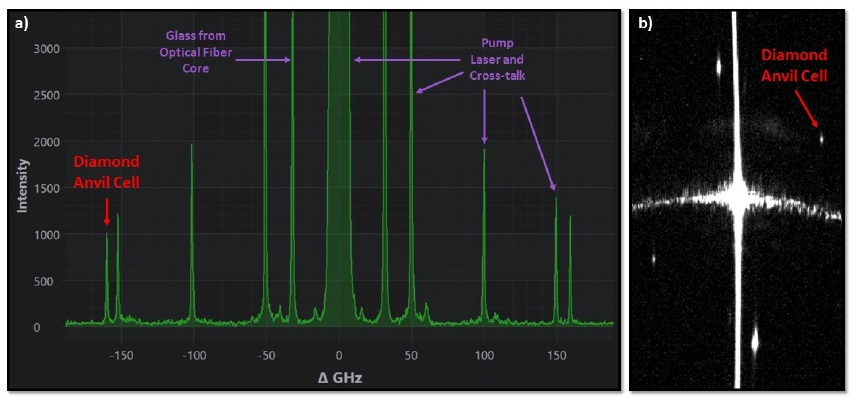A quick test was performed utilizing water in a diamond anvil cell (DAC) set to approximately 1 GPa. The Brillouin spectrum is shown in Figure 1. In accordance with Li et al1, the measured frequency shift of this kind of pressurized water is 15.91 ± 0.02 GHz. This shift is substantially different from water at atmospheric pressure (7.48 ± 0.01 GHz), as seen in the inset of Figure 1.

Figure 1. a) Brillouin frequency spectrum of water in a DAC at approximately 1 GPa. The inset shows the Brillouin spectrum of water at atmospheric pressure. b) Raw sensor image corresponding to the main figure. The exposure time was set to 5 seconds and the number of averages to 5. Image Credit: LightMachinery
A long working distance 20X objective was utilized to gather the Brillouin spectrum in a backscattering geometry. The sample was roughly normal to the objective’s optical axis (limited tilt angle). Therefore, the objective was gathering a proportion of the pump reflection from a variety of surfaces. Yet, the pump suppression and high contrast of the HF-8999-532 spectrometer allowed clear-cut observation of the Brillouin signal. The pump signal may be decreased by several degrees with one of the following approaches: a) utilizing an extra Pump Killer system (HF-10237-532-AUTO), b) heightening the tilt angle of the backscattering geometry, or c) gathering the Brillouin signal in a platelet geometry (transmission geometry utilizing a second objective).

Figure 2. a) Brillouin frequency spectrum of a DAC. The pump laser and cross-talk can be significantly reduced by employing one of the methods mentioned above. b) Raw sensor image. The exposure time was set to 15 seconds and the number of averages to 5. Image Credit: LightMachinery
The DAC’s measured Brillouin shift is 159.59 ± 0.02 GHz as shown in Figure 2. The unambiguous attainment of this signal, well above the FSR of the VIPA, is facilitated by the cross-dispersion of the echelle grating of the system.
Specifications
Source: LightMachinery
| Sample |
System |
- Water in a DAC set to approximately 1 GPa
|
- Power at sample: 12 mW
- Pump wavelength: 532.2 nm
- FWHM of the instrument response: nominal 0.9 GHz
- Excitation/collection with long distance 20X objective
- Repeatability of Brillouin shift: highly sample and exposure dependent; <10 MHz is possible
|
References
1 Li, F., Cui, Q., He, Z., Cui, T., Zhang, J., Zhou, Q., Zou, G. and Sasaki, S., 2005. High pressure-temperature Brillouin study of liquid water: Evidence of the structural transition from low-density water to high-density water. The Journal of chemical physics, 123(17), p.174511.

This information has been sourced, reviewed and adapted from materials provided by LightMachinery.
For more information on this source, please visit LightMachinery.